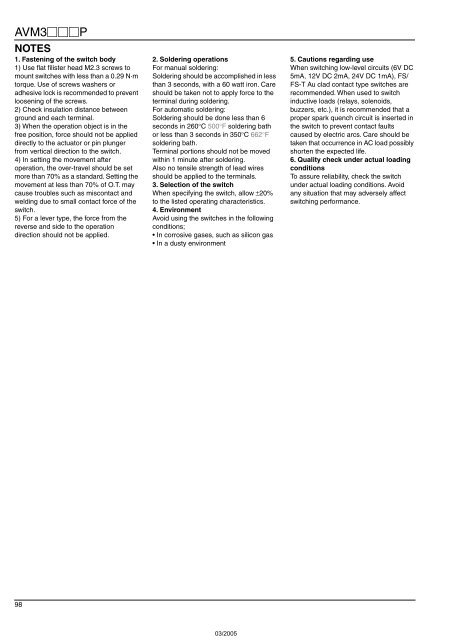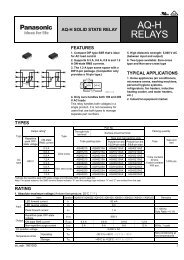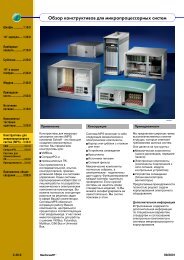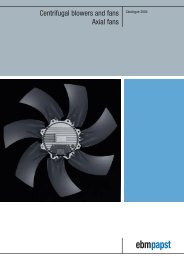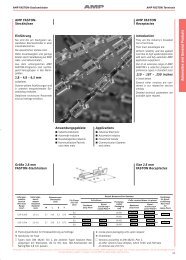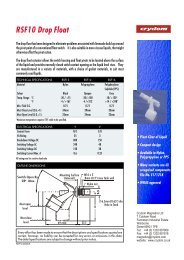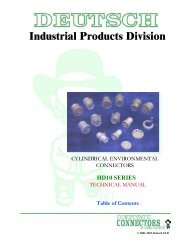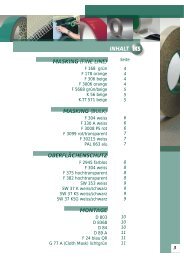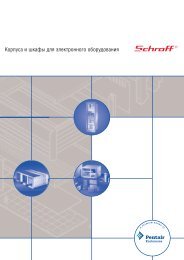Snap-Action Switches Detection Switches General Catalogue 2005
Snap-Action Switches Detection Switches General Catalogue 2005
Snap-Action Switches Detection Switches General Catalogue 2005
You also want an ePaper? Increase the reach of your titles
YUMPU automatically turns print PDFs into web optimized ePapers that Google loves.
AVM3P<br />
NOTES<br />
1. Fastening of the switch body<br />
1) Use flat filister head M2.3 screws to<br />
mount switches with less than a 0.29 N·m<br />
torque. Use of screws washers or<br />
adhesive lock is recommended to prevent<br />
loosening of the screws.<br />
2) Check insulation distance between<br />
ground and each terminal.<br />
3) When the operation object is in the<br />
free position, force should not be applied<br />
directly to the actuator or pin plunger<br />
from vertical direction to the switch.<br />
4) In setting the movement after<br />
operation, the over-travel should be set<br />
more than 70% as a standard. Setting the<br />
movement at less than 70% of O.T. may<br />
cause troubles such as miscontact and<br />
welding due to small contact force of the<br />
switch.<br />
5) For a lever type, the force from the<br />
reverse and side to the operation<br />
direction should not be applied.<br />
2. Soldering operations<br />
For manual soldering:<br />
Soldering should be accomplished in less<br />
than 3 seconds, with a 60 watt iron. Care<br />
should be taken not to apply force to the<br />
terminal during soldering.<br />
For automatic soldering:<br />
Soldering should be done less than 6<br />
seconds in 260°C 500°F soldering bath<br />
or less than 3 seconds in 350°C 662°F<br />
soldering bath.<br />
Terminal portions should not be moved<br />
within 1 minute after soldering.<br />
Also no tensile strength of lead wires<br />
should be applied to the terminals.<br />
3. Selection of the switch<br />
When specifying the switch, allow ±20%<br />
to the listed operating characteristics.<br />
4. Environment<br />
Avoid using the switches in the following<br />
conditions;<br />
• In corrosive gases, such as silicon gas<br />
• In a dusty environment<br />
5. Cautions regarding use<br />
When switching low-level circuits (6V DC<br />
5mA, 12V DC 2mA, 24V DC 1mA), FS/<br />
FS-T Au clad contact type switches are<br />
recommended. When used to switch<br />
inductive loads (relays, solenoids,<br />
buzzers, etc.), it is recommended that a<br />
proper spark quench circuit is inserted in<br />
the switch to prevent contact faults<br />
caused by electric arcs. Care should be<br />
taken that occurrence in AC load possibly<br />
shorten the expected life.<br />
6. Quality check under actual loading<br />
conditions<br />
To assure reliability, check the switch<br />
under actual loading conditions. Avoid<br />
any situation that may adversely affect<br />
switching performance.<br />
98


